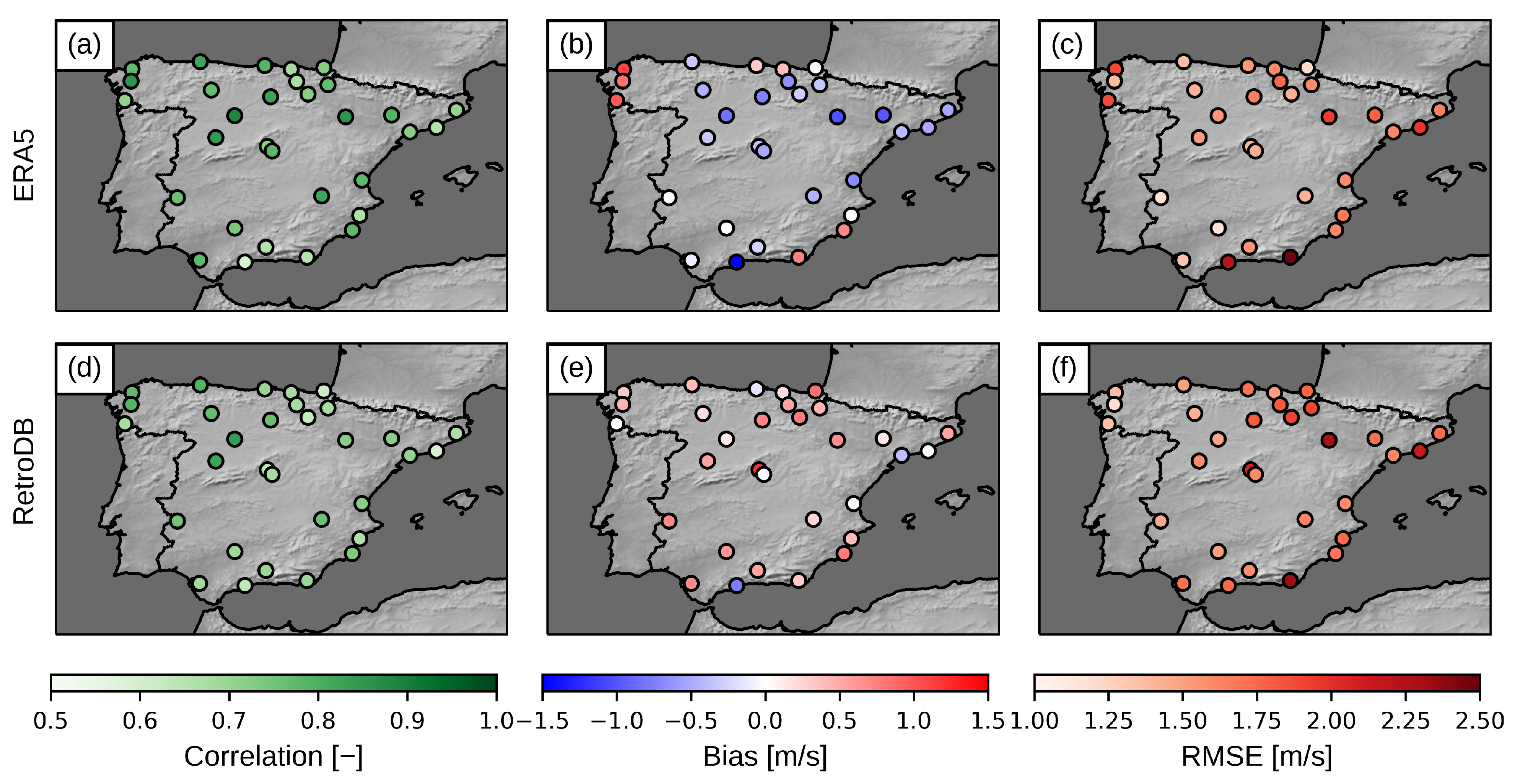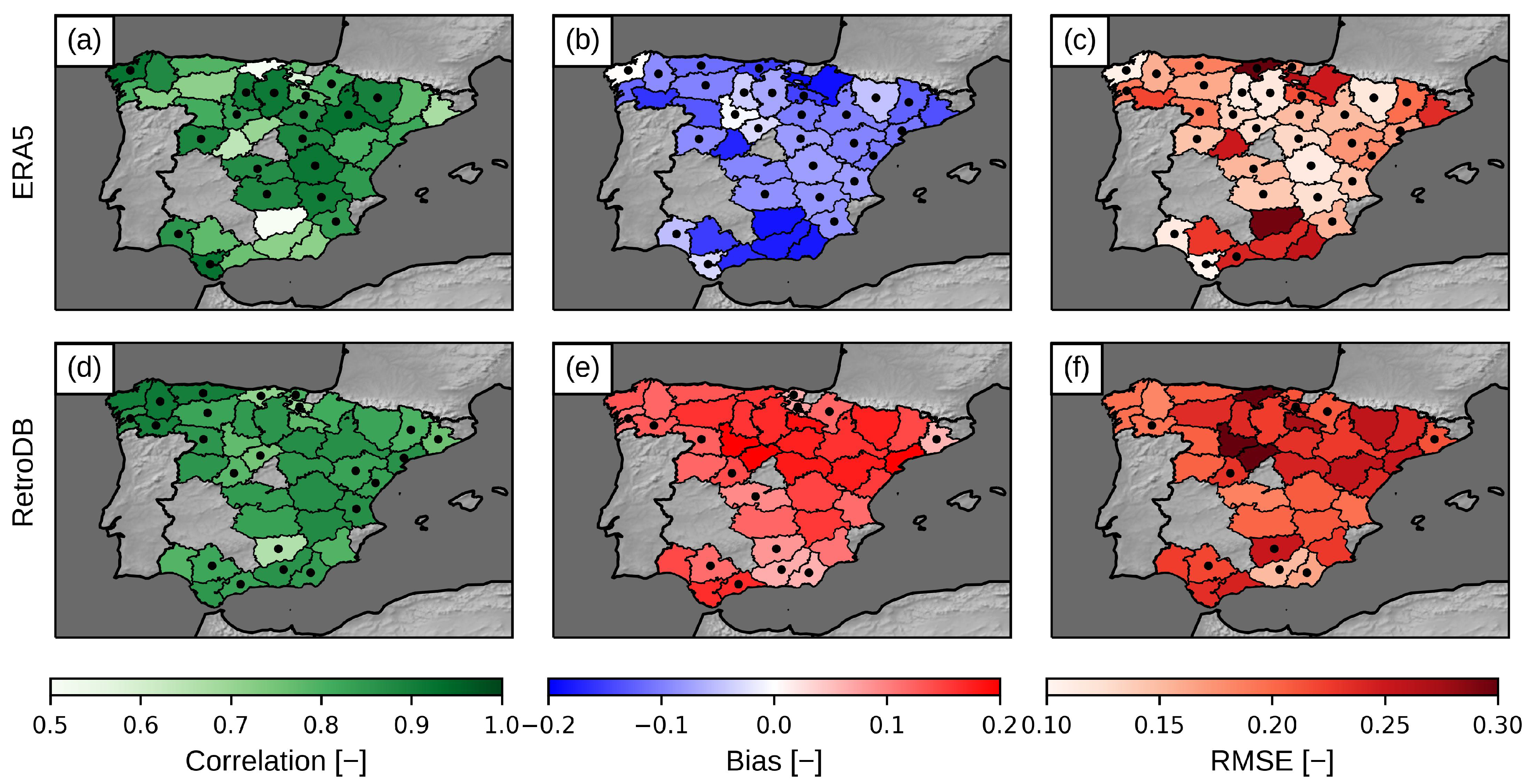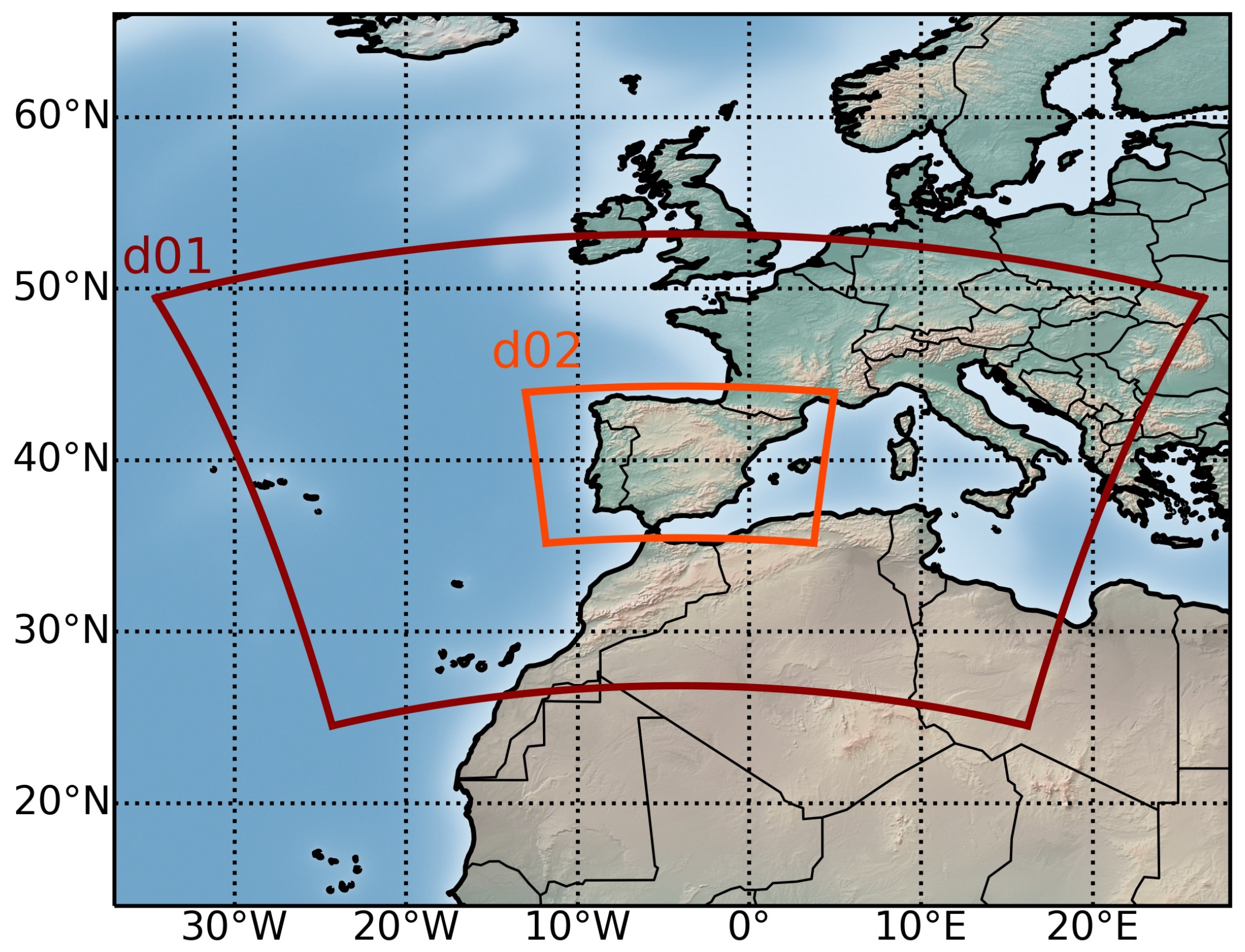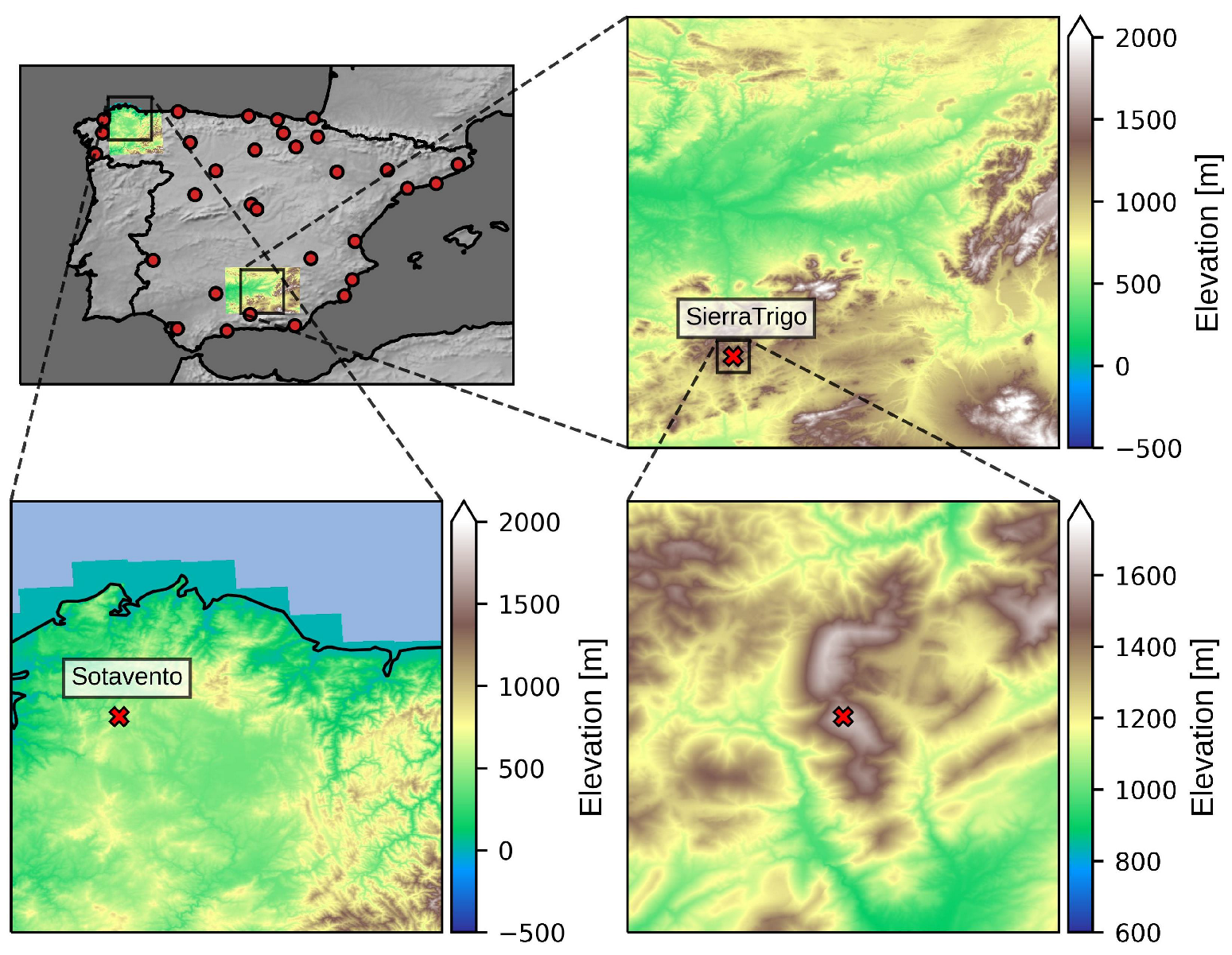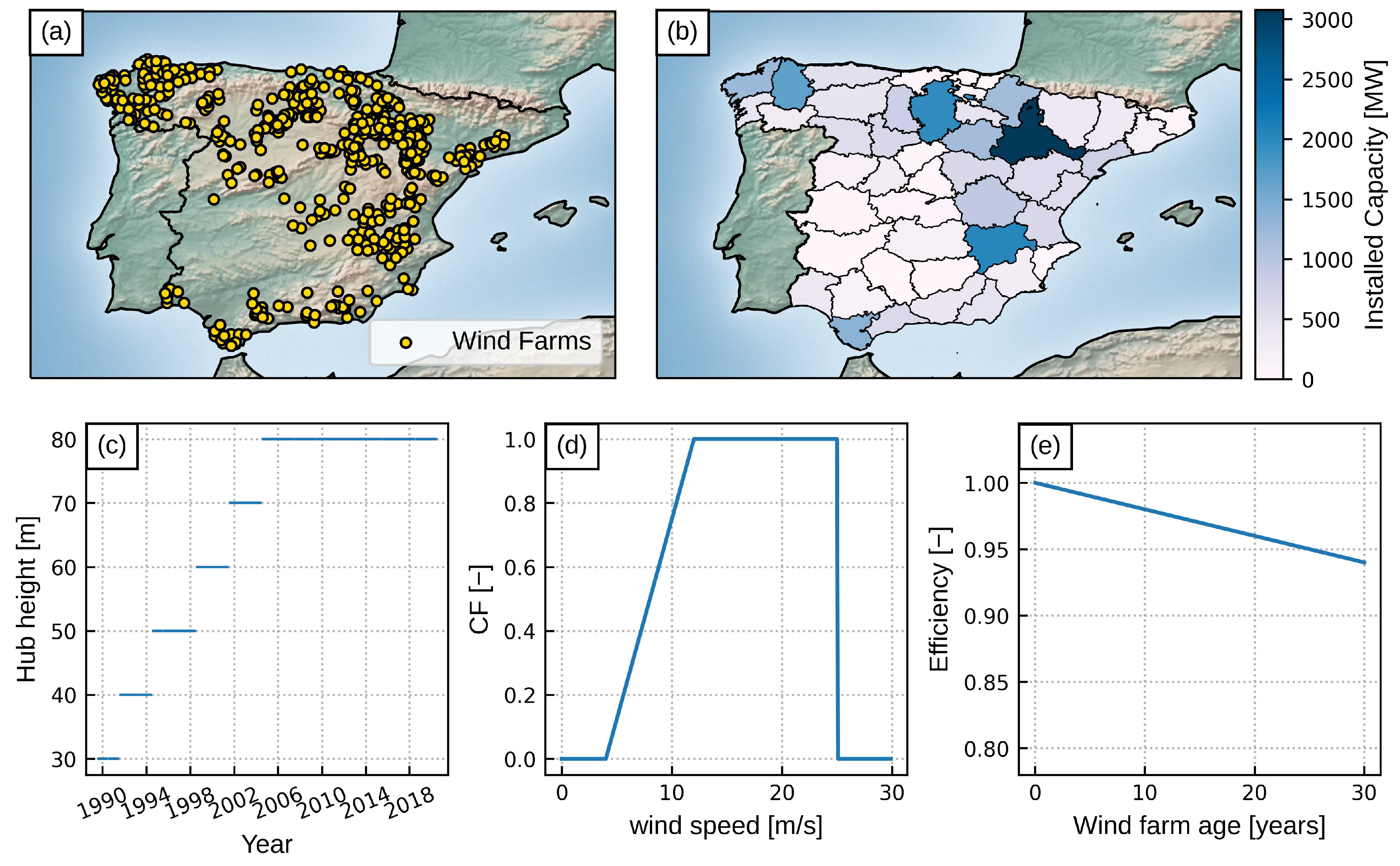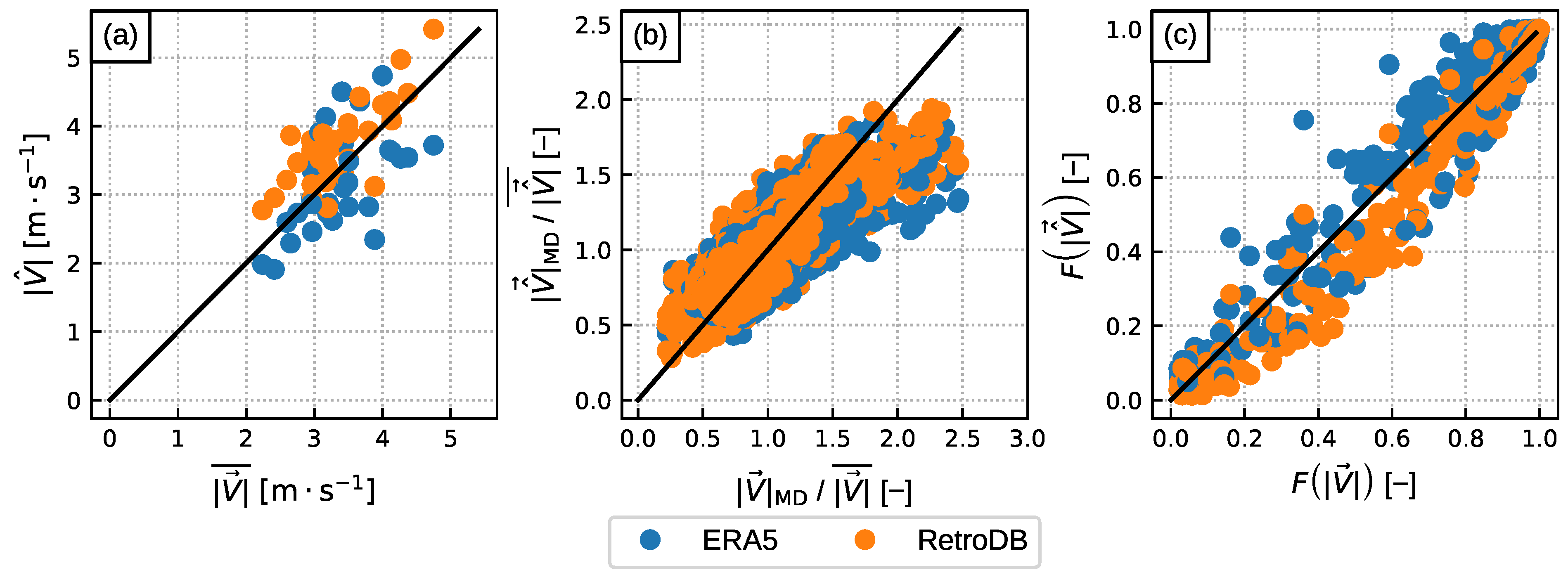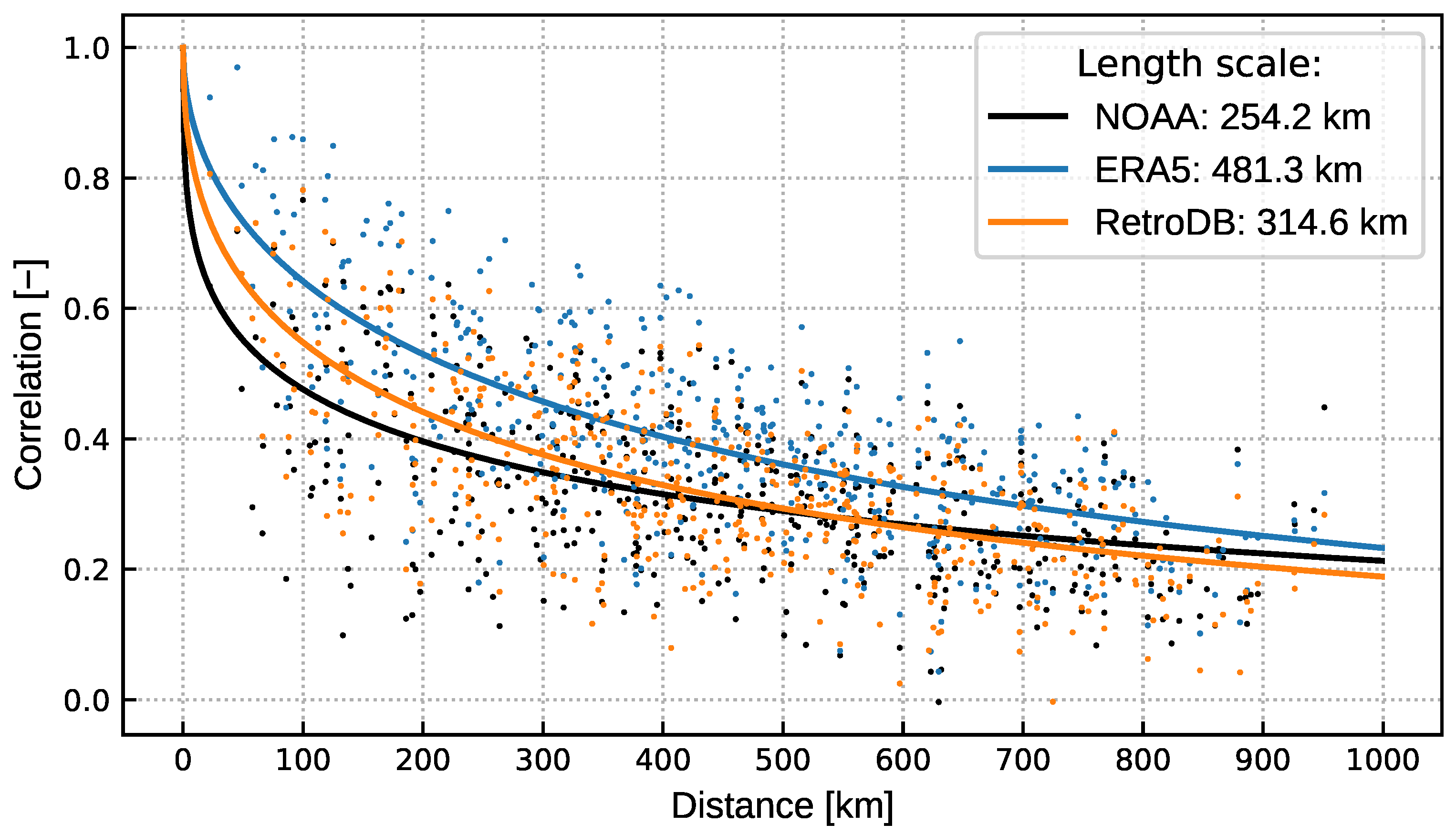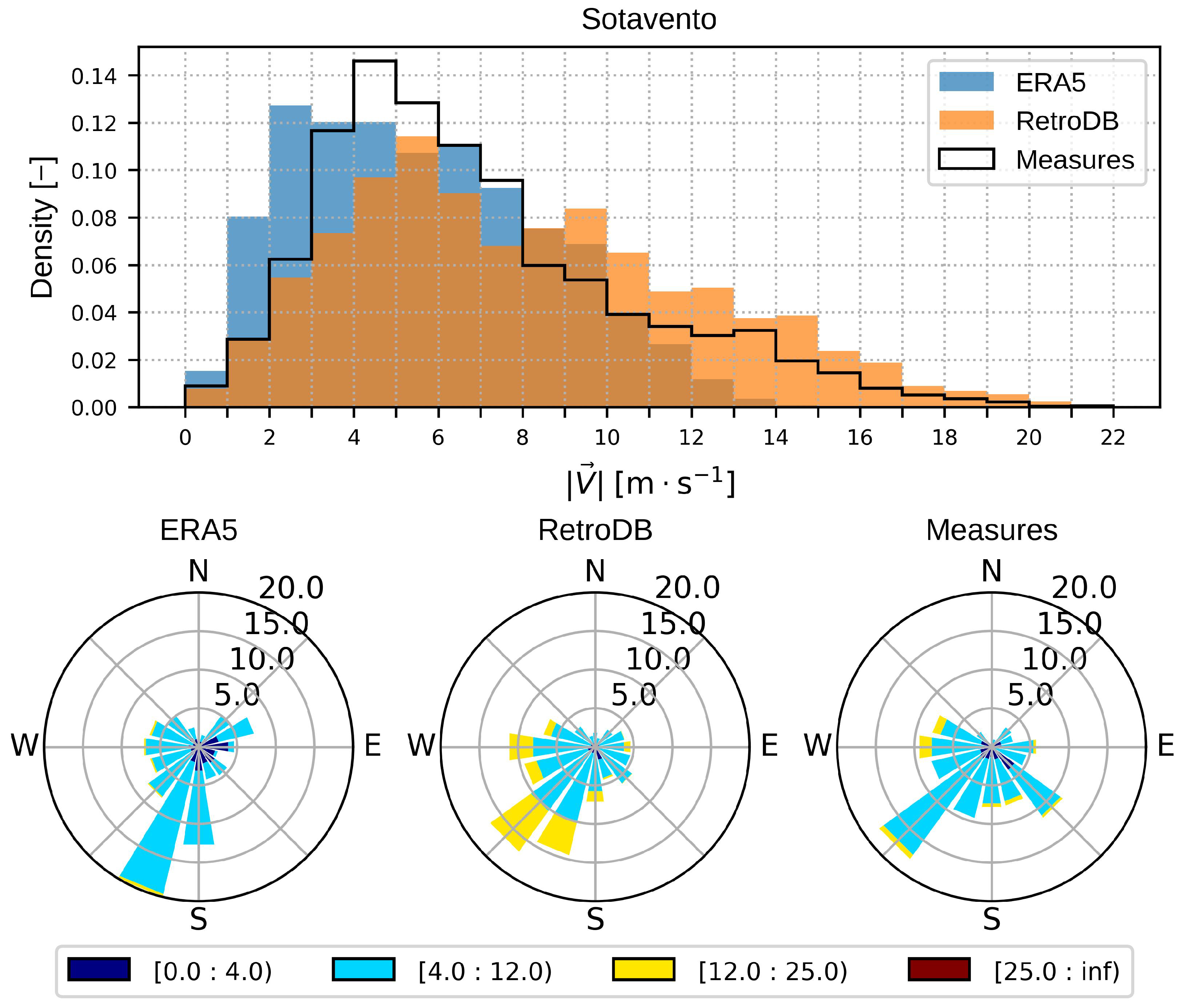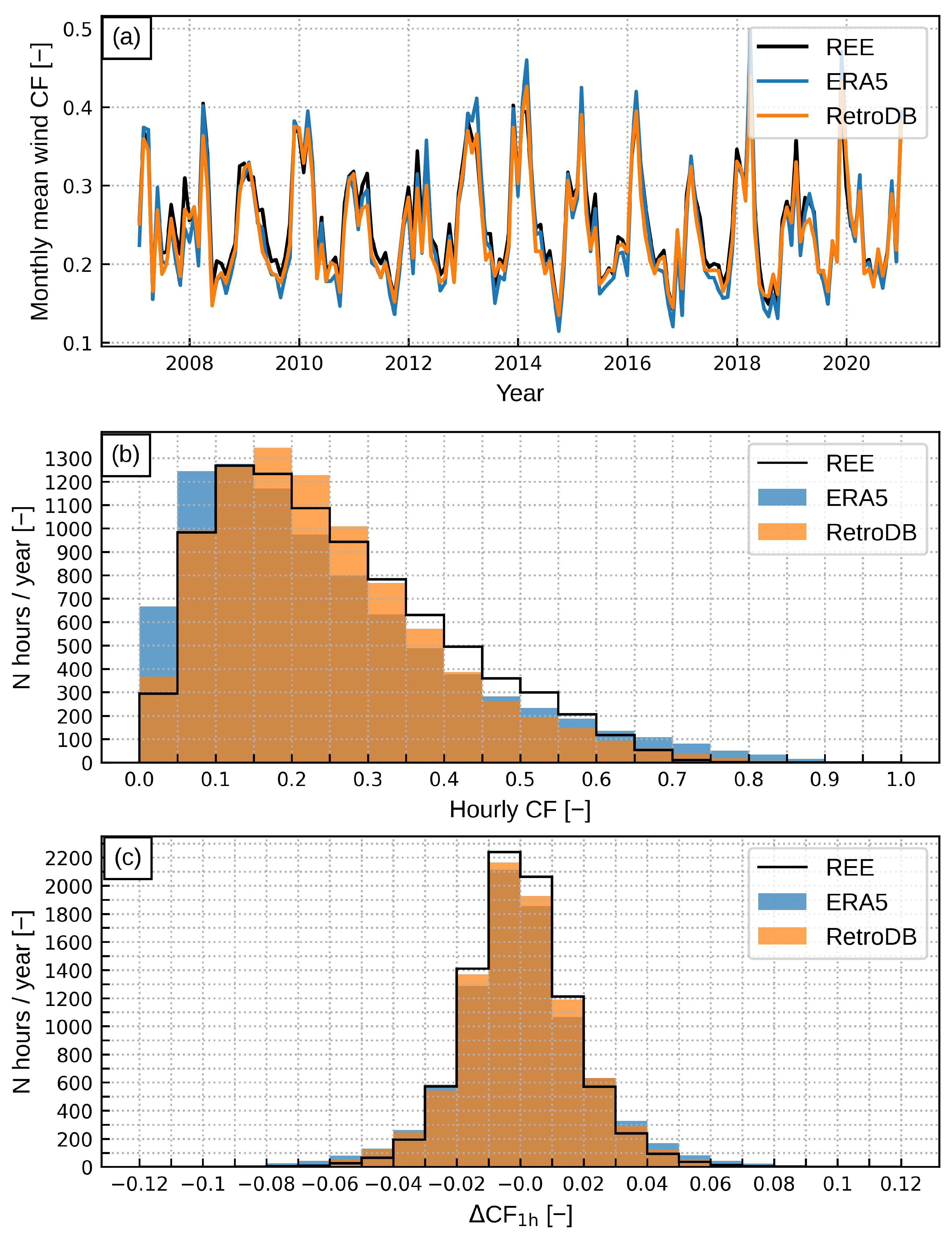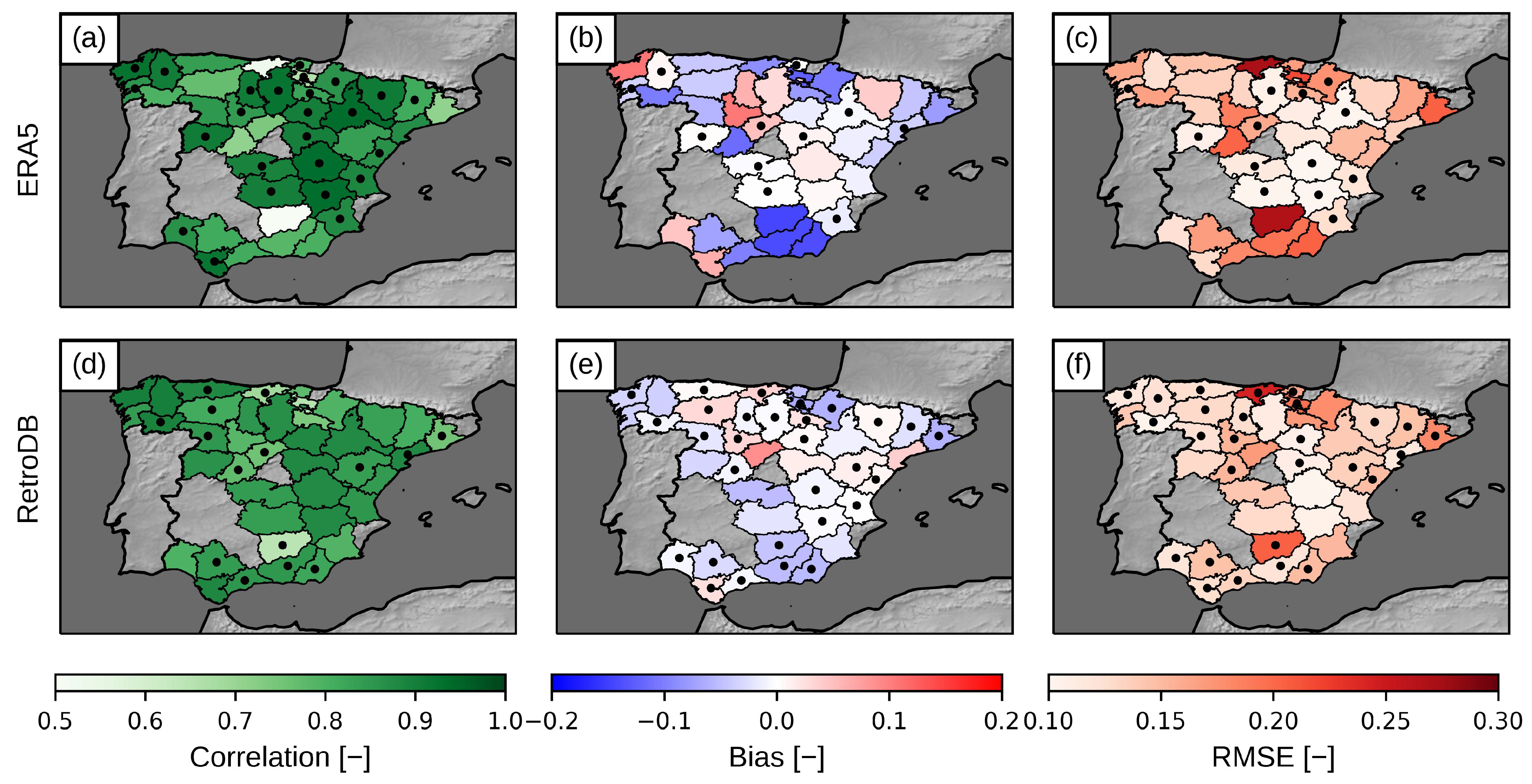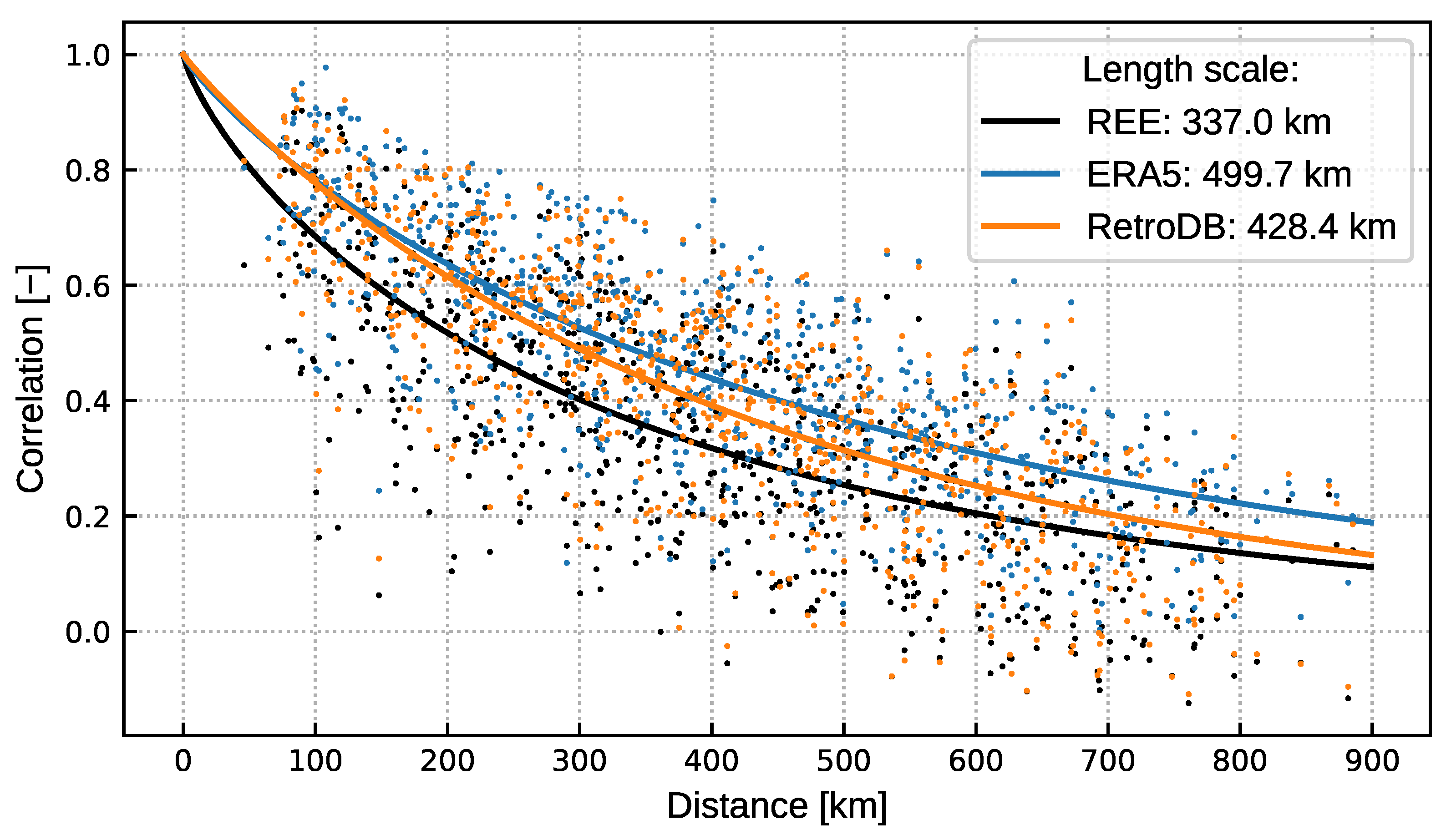1. Introduction
Solar and wind energies are playing a central role in the plans to decarbonise power systems worldwide, fostered by their unprecedented technical and economic competitiveness compared to traditional energy sources [
1,
2]. The European Union has set a 32% target for electricity consumption from renewable energy sources (RESs) by 2030 [
3]. To fulfil that aim, Spain will promote the installation of additional solar PV (about 25 GW) and wind power (about 20 GW) throughout the present decade [
4]. However, the plans to accomplish such targets, which imply a remarkable increase in the grid share of RES, combined with the known intermittency of solar and wind resources (arguably, the most important RES drawback), poses a threat to the reliability of the power supply system [
5]. A way to face this issue is to simulate the grid operation sensitivity to RES fluctuations as a function of their share in the grid and the spatial distribution of the RES plants. This approach features a virtual laboratory to explore electricity grid design mechanisms that may improve its resilience under RES fluctuations, ranging from hours to decades [
6,
7]. Multi-decadal RES databases, with enhanced reliability, are necessary to attain this goal.
Atmospheric reanalyses offer a unique framework for the development of such databases, as they can describe the wind and solar resources over extensive areas and multi-decadal time spans [
8]. To this end, the meteorological information derived from such reanalyses is plugged into power models to compute solar PV and wind power potentials [
9,
10] or to assess the viability of low-carbon power systems [
11]. The performance of these simulations depends on both the quality of the atmospheric inputs and the performance of the RES-to-power models used to transform these quantities into energy estimates [
12]. Indeed, recent years have seen a boost of methods devoted to develop, validate and enhance reanalysis-based RES databases (e.g., by removing biases [
9]) and to devise improved RES-to-power models [
13,
14]. This work, in particular, focuses on the development of a high-performance database of wind resources tailored for wind power assessment in the Spanish grid, as detailed below.
The overall consensus from multiple evaluation studies of wind speed and wind energy estimates derived from global atmospheric reanalyses (hereinafter referred to as GAR) is that, over flat and homogeneous regions, the GAR-based wind speed agrees reasonably well with surface and tall tower measurements [
15,
16], whereas, in areas with complex topography, they tend to underestimate the wind speed observations and to overestimate the probability of low wind speed [
17,
18]. These results justify the need for wind speed bias correction methods [
19]. With regard to wind power, GAR wind speeds were found to be appropriate for evaluate country-wide generation [
20,
21], although extreme generation values are typically underestimated [
9].
A downside of GAR-based datasets is their limited spatial and temporal resolution (tens of km, and hourly, or coarser, time steps), which might explain, at least partially, the disagreements with observations in regions with complex topography. In this respect, the higher spatial and temporal resolutions of regional atmospheric reanalyses (hereinafter referred to as RAR) (a few km and hourly, or finer, time steps) represent an added value with respect to GAR datasets that have been evaluated in recent years. In particular, the enhanced horizontal resolution of RAR datasets allows for a better representation of the land–surface interactions, including topographical effects, resulting in enhanced wind speed estimates [
15,
22]. Indeed, wind speed from GAR and RAR datasets have demonstrated similar accuracy in flat and homogeneous areas [
16,
18], while RAR-based wind speed outperforms GAR-based predictions in areas with complex topography [
23,
24]. Nonetheless, most of the previous RAR-based evaluation studies were conducted in central and northern European regions, characterised by a low topographic complexity, and whose wind resources are mainly driven by favourable atmospheric planetary circulations. Conversely, the wind resource in Mediterranean countries, which is mainly associated with local topographic features and thermal contrasts, has barely been assessed [
25].
In addition, most of the evaluation studies of GAR and RAR are focused on spatial (country) aggregated statistics (wind power) or point validation (wind speed). Nevertheless, little attention has been paid to the ability of these reanalyses to reproduce the spatial and temporal patterns of variability in wind energy resources, which are key for the design of reliable and cost-effective low-carbon power systems. Wind power intermittency can be reduced by making use of the spatial correlation of wind energy resources [
26,
27], while reliable estimates of the wind power generation probability distribution and their ramp distributions play a central role in wind energy integration [
18]. GARs have been found to provide anomalously strong spatial correlations as a consequence of their relatively low spatial resolution [
16]. Pryor et al. [
18] found that, in complex topographic areas, GARs tend to underestimate wind power generation as a consequence of the negative wind speed bias. On the contrary, RARs have been shown to provide an enhanced representation of the marginal distribution of wind power and ramp rates [
24,
28]. However, it has been reported that the daily cycle of wind power generation is hardly reproduced by GARs and even RARs [
16,
29]. It should be highlighted that both the spatial and temporal variability of wind energy resources are highly dependent on the topographic and climatological characteristics of the study area [
30,
31].
The main objective of this work is to provide an open access database (hereinafter referred to as RetroDB) of the wind energy resources of Spain, to be used in energy system analyses and wind energy integration studies in general. The database consists of two parts. The first part contains hourly wind speed estimates at different heights, at 5 km spatial resolution, for the study region, covering the period of 1996–2020. The second part consists of hourly capacity factor (CF) estimates (i.e., wind energy generation values normalised to the installed capacity) for the Spanish NUTS 3 regions [
32] (about 10,000 km
2 average area) along the period of 2007–2020. The RetroDB database was derived from a high spatial resolution integration with the WRF-Solar suite [
33]. The CF values were derived using a physical-based model that makes use of the wind estimates and an upgraded version of the SOWISP dataset [
34]. For the sake of benchmarking, wind and CF estimates were also derived from the ERA5 global reanalysis (hereinafter ERA5 database) following the same procedure. A comprehensive evaluation study of both RetroDB and ERA5 estimates was conducted.
Firstly, wind estimates are evaluated against surface and tall mast measurements. Secondly, upon the wind estimates, regional and national CF estimates were obtained for Spain using a physical model. The extent to which RetroDB and ERA5 reproduced the CF spatial variability, CF distribution, and CF ramp distribution was specifically addressed. The evaluation study allowed addressing the two following scientific questions:
- 1.
To what extent are state-of-the-art global and regional reanalyses able to reproduce the temporal and spatial variability of wind speed and wind energy resources in a country with a Mediterranean climate and whose wind energy resources are tied to topographic features?
- 2.
What is the added value, if any, of high-resolution regional reanalysis in this context?
Several characteristics of the study area make the study worth attempting. Firstly, the study area is located in the Mediterranean area, where wind power estimates derived from global reanalyses have shown a particularly poor performance [
9], and validation studies are scarce [
16,
25]. Secondly, wind resources in the study area are mainly associated with topographic features and local thermal contrast. The topographic effects, particularly, have been shown to account for around 50% of the wind speed in mountainous regions of Spain [
35]. Therefore, the spatial resolution of the databases plays a fundamental role. In addition, Spain has ambitious objectives regarding the wind energy share in their near-future power system.
To the best of the authors’ knowledge, RetroDB is the wind energy CF database of an entire country with the highest spatial resolution released to date. Most databases provide country-aggregated CF values or, at most, for European NUTS 2 regions [
36]. The high spatial resolution of RetroDB allows for a proper analysis of the spatial variability and facilitates the use of the database in wind energy integration studies.
This work is organised as follows.
Section 2 describes the climate of the study region, the WRF model integration and the evaluation datasets.
Section 3 addresses the methods used in this work. The section is divided into two parts. In the first part, the model used to derive the wind power estimates are presented. A procedure for the correction of the CF estimates is also discussed. Secondly, the evaluation statistics and procedures are presented.
Section 4 presents and discusses the evaluation results, firstly for wind speed and secondly for wind energy estimates. Finally, in
Section 5, a summary and some overall conclusions are provided.
5. Summary and Concluding Remarks
This study proposed and evaluated an improved database (RetroDB) of the Spanish wind energy resources, which was derived from a high spatial resolution regional reanalysis performed with the WRF model. Wind energy (CF) estimates were obtained from the wind speed estimates using a state-of-the-art physical model. RetroDB, which provides high spatial and temporal estimates of both wind speed and wind energy CFs, spanning several decades, is made publicly available.
Wind speed and wind energy estimates from RetroDB were benchmarked based on the ERA5 global reanalysis. To do this, first, a set of measurements, derived from surface and tall wind masts, were used to evaluate the wind estimates from both RetroDB and ERA5. Secondly, wind energy estimates, derived from the RetroDB and ERA5 wind databases, were evaluated using the observed values provided by the Spanish TSO. The study area is characterised by a Mediterranean climate and, more importantly, by wind energy resources tied to topographic features. Therefore, and as a by-product, this work evaluates the added value of high-resolution regional reanalysis, compared to global reanalysis, with respect to wind energy studies in areas of complex topography. To this end, the extent to which RetroDB and ERA5 reproduced the spatial variability of CFs, the distribution of CFs, and the ramp distribution of CFs was specifically addressed.
Regarding surface wind estimates, the results showed that ERA5 provides valuable estimates. Nevertheless, RetroDB showed a superior performance at reproducing the spatial variability of wind speed, which has important implications for wind energy integration. Regarding wind aloft, the results clearly showed that the use of the high-resolution regional reanalysis RetroDB instead of ERA5 is advisable. RetroDB’s improved spatial resolution allows for a better representation of the topographic features that account for the majority of wind energy resources in the study region. The advantage is particularly relevant regarding the accurate reproduction of the marginal distribution of the wind speed. These conclusions are constrained by the limited number of evaluation masts (only two), although the location of the towers represents the wind characteristics of most wind farm locations in Spain.
As far as wind energy estimates are concerned, and although a state-of-the-art physical model was used to derive the CFs, the application of a correction procedure was found to be necessary in order to derive reliable estimates. Once corrected, ERA5 and RetroDB showed a similar performance in terms of providing long-term national aggregated CF values. However, when the analysis focused on the ability to reproduce wind CF distributions and ramp distributions, RetroDB clearly outperformed ERA5. As for the surface wind speed, the performance of RetroDB was considerably superior in reproducing the spatial variability of CFs. In summary, the temporal and spatial distribution of the CFs was considerably better reproduced by the high-resolution regional RetroDB reanalysis. A similar conclusion was reported by Frank et al. [
24], who demonstrated that the use of regional reanalysis provides a better estimation of wind energy marginal CF values and ramps distribution. Other previous studies in the scientific literature showed a valuable performance of ERA5 [
16]. Nevertheless, most of these studies were conducted in areas with a relatively low topographic complexity, characterised by wind resources related to regional atmospheric circulation patterns.
The improved performance of the RetroDB in reproducing the wind energy resources in the study area seems to be related to a better representation of the surface wind speed spatial variability and the winds aloft in areas of complex topography. An evaluation of the wind estimates using a tall mast showed that RetroDB, as opposed to ERA5, was able to accurately reproduce marginal wind speed distributions in these areas, where most of the wind farms of the study region are located. The higher spatial resolution of RetroDB allows it to properly represent the wind speed enhancement caused by topographic features. This translates into a better representation of the marginal wind speed temporal and wind speed spatial variability. Ultimately, this leads to an improved representation of the temporal and spatial variability of the CFs in the RetroDB database. An appropriate representation of the extreme CF values have important implications for wind energy integration, since low CF situations may endanger the security of supply, while a high CF may end in curtailment. Similarly, an accurate representation of ramp events has important consequences regarding power system balancing reserves estimation. Lastly, an accurate representation of spatial variability is crucial, for instance, for the proper deployment of wind energy.
Overall, the results obtained in this study clearly indicate that, in areas such as the study region, with wind resources associated primarily with topographic enhancements, the high spatial resolution regional reanalysis shows a clear advantage over relatively coarse reanalysis, such as ERA5, particularly regarding wind energy integration studies. Future studies will attempt to quantify this advantage for reliable energy system modelling.
